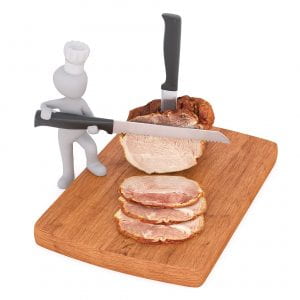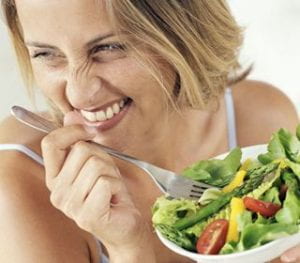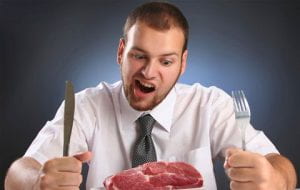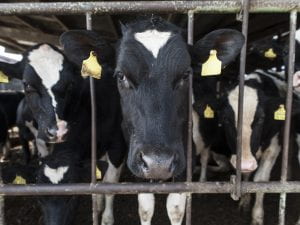 Looking at this image you can see a clearly male image cutting a ham that looks like it sat on a grocery store’s shelves for months. The color of the meat shows that pale greyish look characteristic of meat that comes from factory farms and then sent off through the channels to eventually land at your local Wal-Mart. The size difference between the meat and the human character shows us how much we rely on meat. By showing the ham so large and the human so tiny, it is representational of the fact that we allow meat to be a too large part of our lives.
Looking at this image you can see a clearly male image cutting a ham that looks like it sat on a grocery store’s shelves for months. The color of the meat shows that pale greyish look characteristic of meat that comes from factory farms and then sent off through the channels to eventually land at your local Wal-Mart. The size difference between the meat and the human character shows us how much we rely on meat. By showing the ham so large and the human so tiny, it is representational of the fact that we allow meat to be a too large part of our lives.
We live in a society where the outlook on gendered food is beginning to change. If you google man eating and woman eating, it garners pretty similar images compared to when the Eisenberg article was written in 2016. In Eisenberg’s second paragraph she instructs us to google these two phrases and to see what the results are. She tells us her results were of men eating steak and women eating salad. When I googled this, most results for both were pasta and salad. This is not to say that the gendered assumptions are gone though.
 I watch a lot of night time television and this week I paid close attention to everyone’s plates. The only time I saw anyone sitting down to dinner was in an episode of Law and Order: SVU where they go to arrest the suspect at a dinner. He gets up from the table and we see a clear shot of this hyper-masculine man’s plate being a medium-rare steak. Dining with him is a woman eating a salad. In Pulp Fiction, John Travolta’s character gets a menu and says “Let’s see, steak, steak, steak…bloody as hell” while Uma Thurman’s character instead prefers a burger and a shake. Looking back through television shows and movies you can see the clear assumption in most restaurant dining scenes: the man has a bloody steak and the woman has a dainty salad or something else deemed feminine. What is it with a salad that so speaks to femininity and a steak that speaks to masculinity?
I watch a lot of night time television and this week I paid close attention to everyone’s plates. The only time I saw anyone sitting down to dinner was in an episode of Law and Order: SVU where they go to arrest the suspect at a dinner. He gets up from the table and we see a clear shot of this hyper-masculine man’s plate being a medium-rare steak. Dining with him is a woman eating a salad. In Pulp Fiction, John Travolta’s character gets a menu and says “Let’s see, steak, steak, steak…bloody as hell” while Uma Thurman’s character instead prefers a burger and a shake. Looking back through television shows and movies you can see the clear assumption in most restaurant dining scenes: the man has a bloody steak and the woman has a dainty salad or something else deemed feminine. What is it with a salad that so speaks to femininity and a steak that speaks to masculinity?
Just as the patriarchy has oppressed women, it oppresses the world around it. Animals are “grown” for food, kept  in conditions that most Americans choose to pretend doesn’t exist. I have met countless people that say they prefer to pretend their meat is not a living animal. Why do we choose to live in ignorance rather than change the world around us? Isn’t one still being an oppressor even if they refuse to acknowledge it? Curtin makes it clear that “one need not be aware of the fact that one’s food practices oppress others in order to be an oppressor” (Curtin 2).
in conditions that most Americans choose to pretend doesn’t exist. I have met countless people that say they prefer to pretend their meat is not a living animal. Why do we choose to live in ignorance rather than change the world around us? Isn’t one still being an oppressor even if they refuse to acknowledge it? Curtin makes it clear that “one need not be aware of the fact that one’s food practices oppress others in order to be an oppressor” (Curtin 2).
The patriarchy is a form of oppression held up by multiple systems- racism, classism, sexism and speciesism (Gaard 20). Without one, the whole system collapses.
Ecofeminism believes that all biological beings are equally deserving of the same equal rights. Regardless of one’s race, gender, class or species. Gaard talks about the keeping of pets as subjects, controlling their every whim and explaining how despite the kindness and compassion we exhibit towards these animals, it is still oppression of another species. We are still feeding into these systems upholding the oppression.
Curtin brings a different light to the subject, discussing moral vegetarianism and how we  oppress animals in order to feed ourselves. They discuss how our patriarchal society influences us to consume meat and further this oppression.
oppress animals in order to feed ourselves. They discuss how our patriarchal society influences us to consume meat and further this oppression.
What these two authors have in common is their shared agenda of promoting positive and equal relations between humans and animals. Both authors stress a compassionate relationship to non-human animals by making “sympathetic connections” (Gaard 120) between “the oppression of women and the oppression of non-human animals” (Curtin 1).
Works Cited

Test
Retest
Thanks for your post, Keira. I didn’t notice the size difference between the doughboy and the ‘meat’ but I did notice the color. That’s one of the issues that lead to my distaste for the image. The idea that the image would propagandize the meat as highly important is no surprise. I think of Carl’s Jr’s ads with the scantily clad woman eating a burger and the sauce dripping down into her cleavage, which of course, is large and very overt. Why oh why? From taking this course now we know. I knew before that women were literally “used” as sexual props to sell shit. It always left me with an understanding that whatever the ad was selling, I was not buying.
Advertisements that depict women in anything other than on an equal playing field as men have always made my decisions for me. I had to wonder, are they selling sex or a product? If they were using sex and objectification of women/women’s bodies, I was not going to bite. No way. Not happening. Having raised two daughters and instilling in them the same sensibilities about advertising, I am proud to say they see it clearly and also deny those companies access to their wallets.
I agree with you that, in today’s world, men and women seem to share a greater percentage of images involving vegetables, and fruit. And even though most of my daughter’s friends are vegetarian or vegan, most of my friends are carnivorous. To me, this has become a generational change in eating habits, not only for health reasons but also for moral and humanitarian. As I’ve stated earlier, my younger daughter, now 27, became a vegan at the age of 8 or 9 and begged me to watch PETA videos that depict how inhumanely and demonic the factory farming industry is, all done for the sake of the Almighty Dollar.
https://support.peta.org/page/16275/donate/1?utm_source=PETA::Google&utm_medium=Ad&utm_campaign=0120::gen::PETA::Google::Paid::eg::searchad&supporter.appealCode=IXXXWBXXXXG&gclid=Cj0KCQiA4sjyBRC5ARIsAEHsELHDH8jiYgkss-rhkVC6Rp-OvVdpRYiKqD46ZoFHmw00_cODDd99UfcaAidwEALw_wcB
You’re right that many people choose to live in ignorance and denial about where their food comes from. Denial is one of the most powerful human emotions. It can halt us in our tracks and gives us a tool to overlook just about any kind of horrific thing. Genocides have been included in the denial of humans to see what’s occurring even in their own backyards. Animal genocide is no different. Nature genocide is no different. They’re different sides of the same coin. Until we see all life as intricately linked, breathing and growing as one, we will not change.
Thanks again for your post and…let’s change how we treat all living things, with love, compassion and care.
Hi Kiera,
I found your blog a little difficult to read. It seems biased and has some misinformation. Having said that, the first sentence in your opening paragraph where you wrote; Looking at this image you can see a clearly male image cutting a ham that looks like it sat on a grocery store’s shelves for months.” first why are you assuming automatically that the figure is a male figure? To me it appears unisex, it has no visible genitalia, so I don’t automatically see your connection to it being male. Second, this looks to me like a pork roast, not a ham as you suggested, which when cooked properly is that color. The bias here might cause a reader especially someone familiar with cooking to consider this as being not credible.
In your gendered foods paragraph, you commented on the google search that the author suggested we do. Do you think this was stereotypical information that the author was providing? Or do you think that perceptions among gendered foods has changed in recent years? My thoughts on that is with the Keto diet becoming more popular among women, there will be more images of women eating meat than ever before.
In the reference of the film PulpFiction, you mentioned that Travolta orders a steak “bloody as hell.” And Thurman orders a burger, but she too orders her burger “bloody as hell.” https://youtu.be/78RUyWC–bQ At 1:23 in the film, you can see the scene of them both ordering bloody meat. A hamburger and a steak are both beef, and are no different in my opinion. In what film were you referring where the man orders a steak and the woman a dainty salad? I do believe that there are gendered foods and that society has conditioned women to eat more healthy foods. However, I feel that it’s due to the fact that women have been made to believe that we have to keep a slim figure to attract men. Whereas, men don’t have that pressure, so they are free to eat as they like without judgment.
I did agree with your comparison about the authors and how they both had similar messages of compassion for non-human animals. I think they want us to be aware that by consuming animals we are oppressors. They want us to acknowledge our role in the oppression of animals. By being aware perhaps our compassion for animals will grow and we can begin to make different choices when deciding what to eat.
In closing, I think that as feminists we sometimes come off to non-feminists as radical in our beliefs. To combat that, I think the burden is on us to make sure we communicate in an unbiased way, and with having fact checked our rhetoric.
Hey!
Okay, so I also googled “woman eating food” and “man eating food” and both search results showed a mix of both genders eating plant food and giant cheeseburgers. So, that’s interesting. I still think when companies advertise it is more related to the traditional gendered stereotype. For example, there is a lot of advertisement for yogurt directed toward women. However, guys can eat yogurt too and also it also promotes digestive health whether biologically male or female. According to a Live Strong article, 6 oz of greek yogurt can give you as much as 18 g of protein!
https://www.livestrong.com/article/260489-what-are-the-benefits-of-yogurt-for-men/
In your blog when you spoke about the ignorance of people choosing not to see their food and meat as animals, is often something I questioned myself. In America and our culture I find that with many things in our society we as people just turn a blind eye because we do not to admit the problems that we have as a whole. We see this in industries like technology and clothes. We known that products like Apple and expensive Clothing brands like Nike are made over seas and often their factories and locations are underpaying workers and their products are made dirt cheap just to charge us hundreds of dollars.
In particular to food I find that it is easier for people to dismiss the cruelty of animals because it is not directly in our sight. in a New York Times post called “Eating Meat Is Also Animal Abuse” the author discusses the uproar we as people have when someone abuses a pet, she gave examples of Michael Vick and Kisha Curtis who did despicable things to dogs . However when killing over 58 billion animals a year for ingestion of food there is no backlash. “There is no morally coherent difference between the cat who was kicked and the chicken, pig, cow or fish that most people will eat today”( Gary L. Francione). I think that we have to look at our selves and culture and see how we can address the issue if animal farms and cruelty for all animals in life.